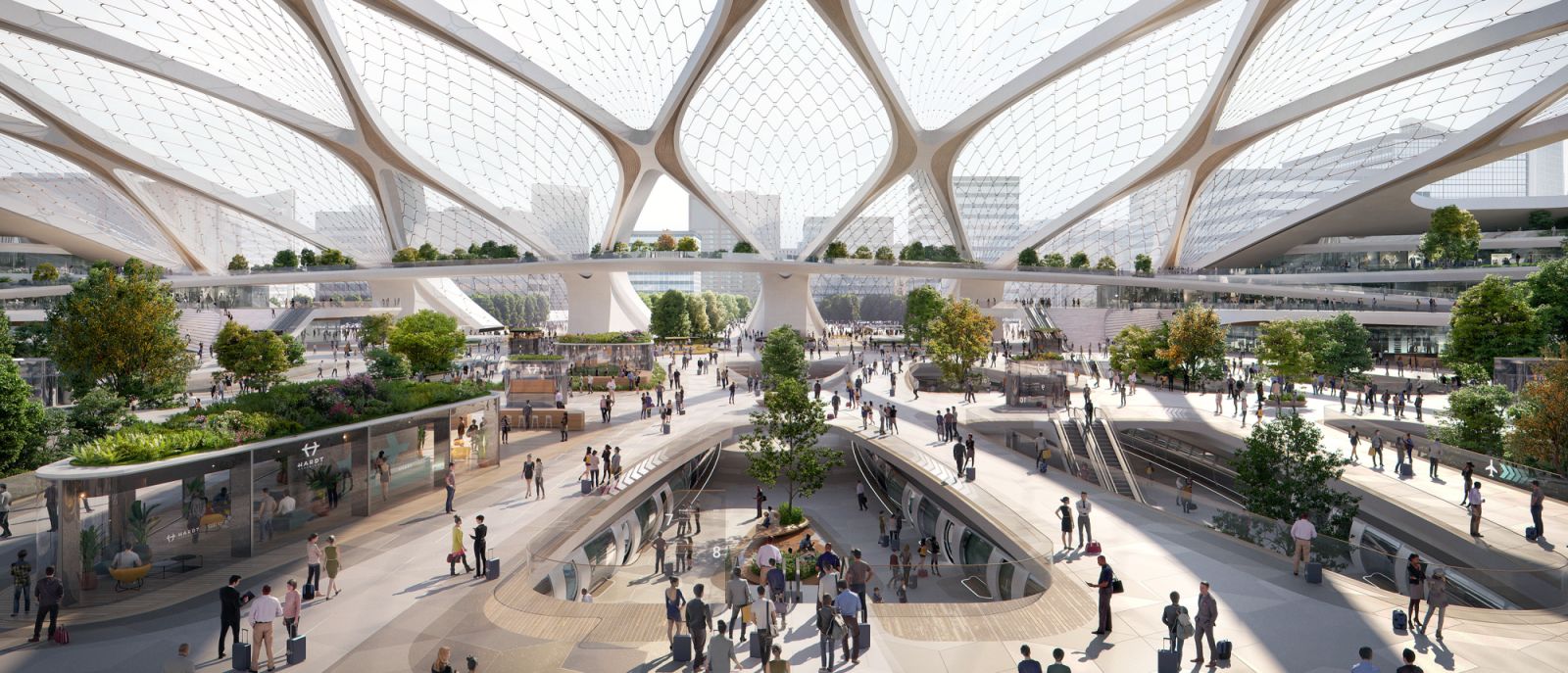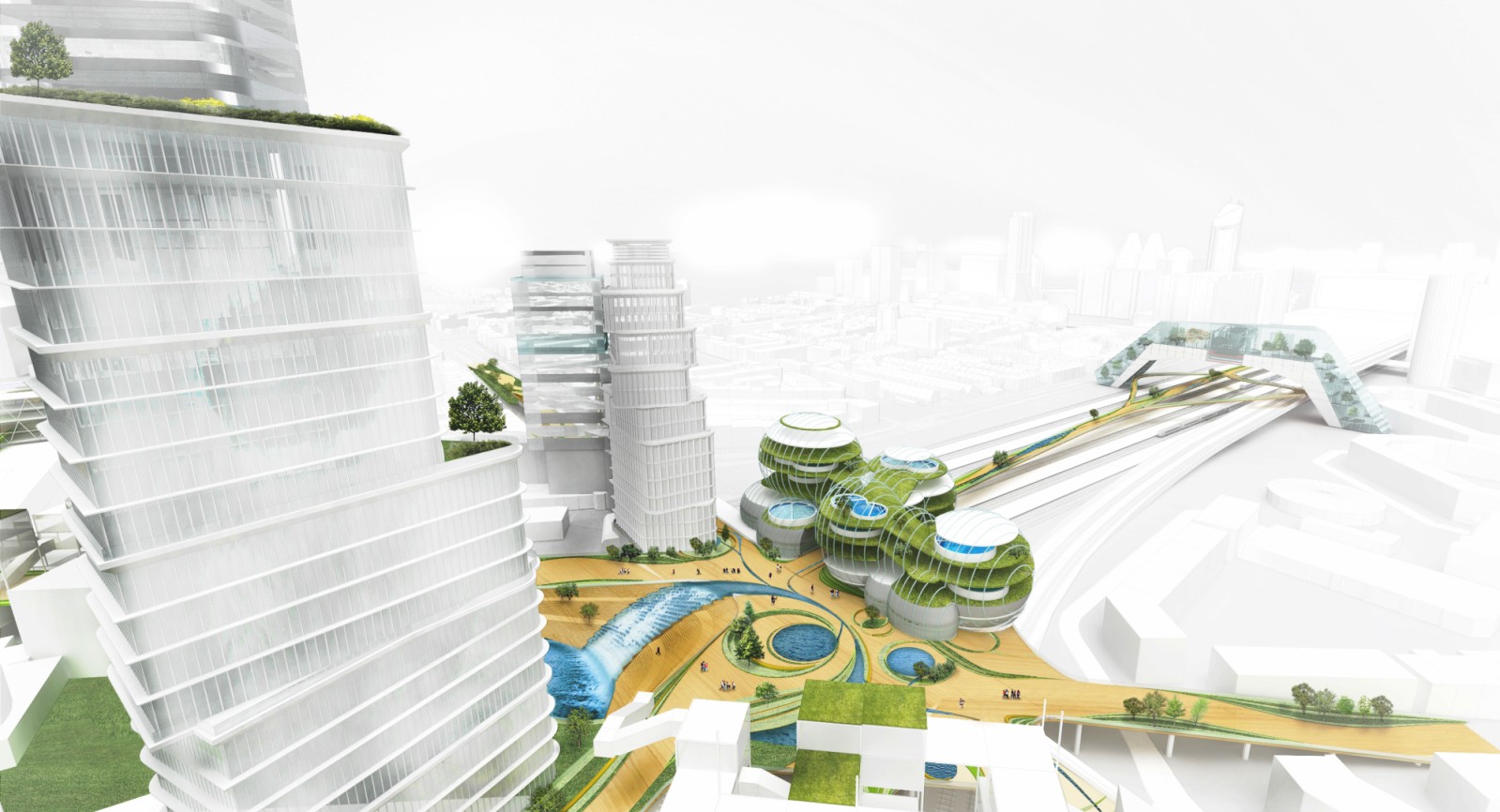The CID test site covers a 1 x 1 km area in the centre of The Hague; currently a major infrastructure hub within the triangle of the Hague Central Station and two nearby stations, but in the future vision of the Socio-Technical City it becomes a green, self-sufficient double-layered district, where a new urban layer of housing, offices, urban mobility and park-like public space is composed over the existing train track infrastructure.
The City of the Future
UNStudio’s vision for The Hague is one of the studies made for ‘The City of the Future’. The project started in January 2018, when 10 multidisciplinary design teams were tasked with investigating new ways of city-making using five test locations in Amsterdam, Rotterdam, The Hague, Utrecht and Eindhoven. These teams included landscape architects, urban planners, mobility experts, experts in the field of circular economy, energy transition, future strategies, big data, smart cities etc. The teams worked on a level playing field together with municipalities, stakeholders and experts in the field of important innovations. UNStudio’s concept for the Socio-Technical City combines the two largest challenges facing the future of cities, urbanisation and sustainability .
Gateways: Catalysts for encounter and innovation
UNStudio’s urban vision distinguishes a number of technical ‘domains’, which refer to the major transition issues of our time: energy, circularity, mobility, climate adaptation / water management and food production. These domains are then each envisioned as ‘gateways’: physical architectural interventions that offer practical solutions to the problems as well as functioning as attractive symbols for the specific themes – a geothermal power station as an icon for energy transition, a (Hyperloop) station as a landmark for mobility, a Biopolus water treatment plant as a symbol for circularity.

Gateway Mobility: the Metropolitan Superhub
The existence of three intercity stations within walking distance of each other presents an unprecedented opportunity to transform this area into one Metropolitan Superhub; a system of closely linked terminals. It also provides an opportunity to create space for new forms of sustainable mobility such as the Hyperloop, with a free floating system of electric scooters, and possibly self-driving pods, interlinking the different modes of public transport.
Gateway Geothermal Energy Plant
In order to make the district self-sufficient and energy-neutral, a solution was found by way of a system of ‘energy exchange’ with the surrounding districts. The geothermal energy plant draws energy from a hot water reservoir that is 2.5 kilometers below ground and supplies it to the surrounding low-rise districts. The energy gateway is not only a geothermal power plant, but also a bridge that connects neighbourhoods, a winter garden and co-working space for start-ups. But above all it is a symbol for energy transition: an energy cathedral.

Gateway the Biopolus
The Biopolus ensures that the waste water from the new part of the city is purified and the nutrients that are released are used for the cultivation of crops. Waste water is pumped through tubes to the highest level, after which it flows to the lowest level via various purification processes, producing drinking quality water which then enters the system again. The localised cycle is complete. The Biopolus is however not merely a water purification plant, it is also an urban farm, a vertical park and an emblem of the circular economy.
Gateway Climate Adaptation: Water plazas
Climate change presents significant risk factors for the area, such as flooding and overheating. Where currently rainwater, waste water and grey water are all disposed of through one drainage system, in the Socio-Technical City this is separated into different systems. Waste water is drained through underground pipes, however the relatively clean rain water is re-used and made visible in the form of water features in public spaces: an irrigation system of canals, water plazas and waterfalls. Source by UNStudio.

- Location: The Hague, Netherlands
- Architect: UNStudio
- Project Team: Ben van Berkel with Lars van Hoften and Dana Behrman, Maria Zafeiriadou, Ren Yee, Chen Shijie, Qiao Xu, Nina Soltani, Takumi Kozuki
- Model Team: Patrik Noome, Bart Bonenkamp
- Gateway visualisations: by Plompmozes
- Urban technology: UNSense
- Landscape Architects: Felixx
- Energy: DGMR
- Circularity: Metabolic
- Climate Adaptation: Nelen Schuurmans
- Data Mobility: Here Technologies
- Year: 2018
- Images: Courtesy of UNStudio










